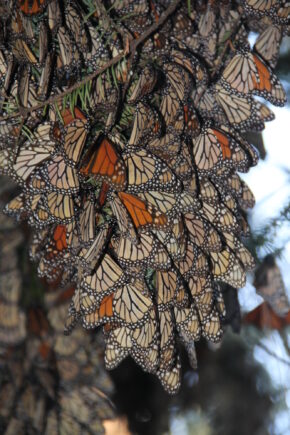Mexico

Each year, monarchs east of the Rocky Mountains from as far north as Ontario, Canada, migrate south to the same overwintering sites along central Mexico's Transvolcanic Range. The stands of oyamel fir where monarchs roost are being threatened by forest degradation due to legal and illegal logging, land conversion for farming, and climate change that may negatively affect the oyamel firs. The degradation of these sites can have very harmful effects on overwintering monarch populations. The oyamel fir stands serve as both a blanket and umbrella during the winter, protecting monarchs from extreme cold temperatures and precipitation. The encroachment of logging near overwintering sites and forest degradation from other causes can alter the microclimate there which may increase monarch mortality.
While many government policies promote sustainable forest management and ban most logging in the areas in which monarchs overwinter in Mexico, these regulations and incentives have not been 100% effective. While illegal logging accounts for much of the forest loss in the Monarch Butterfly Biosphere Reserve, a smaller number of trees are still removed by authorized extraction or by individuals cutting down trees for firewood or building houses.
Subsistence-farming activities may also impact oyamel fir forests and the monarchs that overwinter there. With the diversion of water for human use, monarchs may be forced to travel further in search of water, which may deplete their lipid reserves more quickly. Oyamel fir stands may also be threatened by the impending effects of climate change. Recent climate change models suggest that these forests may be exposed higher stress from heat and drought which may cause them to be more vulnerable to insects and disease. Some level of forest and overwintering habitat degradation may also be caused by unregulated tourism in the monarch overwintering areas.
California

Monarchs west of the Rockies migrate to many locations along the Pacific coast of California, though some monarchs tagged in western states have been recovered in Mexico, suggesting there is some interchange between eastern and western populations. Overwintering populations in California have been estimated annually by community scientists since the mid 1990s. These data, along with other historic overwintering site evaluations, were compiled by the Xerces Society for Invertebrate Conservation into a comprehensive database of current and historic western monarch overwintering locations. While not all of these sites are monitored each year, and year-to-year population fluctuation may be the result of drought or other climate conditions, the long-term trend of the western monarch overwintering population is downward.
The cause of this downward trend in the western population is not fully understood, but habitat loss in overwintering locations is a major issue of concern. Municipal and commercial development in these areas is conceivably the most damaging to western overwintering habitat. Numerous known overwintering locations have been lost as a result of new housing developments or expansions. While increasing awareness of monarchs and their decline can help to boost conservation efforts, increasing tourism inspired by monarchs can drive an increase in development and pollution near overwintering sites, which can have harmful effects on overwintering clusters.
Western overwintering sites have a similar microclimate to sites in Mexico, and are usually comprised of eucalyptus, Monterey cypress, Monterey pine, and western sycamore trees. Monarchs cluster in the non-native eucalyptus trees as well as the native tree species, but research suggests that eucalyptus may not actually be a preferred species, just one of convenience. Land management to restore these sites is difficult because native trees are generally much more slow-growing than the non-native eucalyptus. Long-term management plans need to be in place to restore these sites back to their native state to ensure the future and abundance of quality western overwintering habitat.
